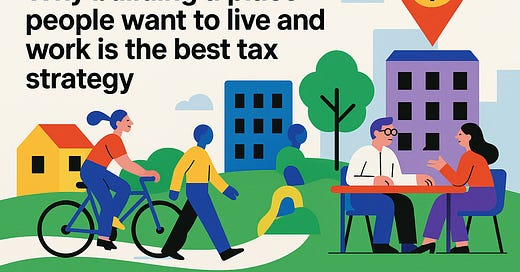On Taxes – Why building a place people want to live and work is the best tax strategy
It's budget season, y'all.
TL;DR: Philly faces a critical choice in tax policy. We can either continue chasing suburbanites by building for cars and limiting Philly’s potential, or we can invest in making our city a place people and businesses want to be—creating a virtuous cycle where improved quality of life attracts more residents and businesses, thus expanding our tax base naturally. (And by pivoting to land value tax to align the city with residents, using the city’s one resource for everyone’s benefit)
As budget season heats up in Philadelphia, we're seeing the usual tug-of-war over tax policy. Mayor Parker wants to cut business and wage taxes while eliminating exemptions for smaller businesses. The Working Families Party is pushing for a wealth tax and expanded protections for small businesses. And urbanist groups continue advocating for land value taxation.
What's missing from this conversation is the connection between our built environment and our tax base. The best tax strategy isn't about rates—it's about creating a place where people actually want to live and work.
The False Promise of Commuters
For decades, Philadelphia has been chasing commuters, providing cheap parking and plowing highways through the center of the city, hoping they'll choose our city over the suburbs or other metros. But this race to the bottom strategy has fundamental flaws:
We're competing with places that will always have lower costs, especially in an era where remote work makes location less relevant
Every accommodation for a suburbanite driving into the city means a worse city to live in – which means lower land values and less revenue for the services that make a city livable, accelerating the cycle
The drivers we attract to the city build up businesses that are scraping by in the city, putting us in an even more precarious position when we want to make the financially responsible decision to focus on residents instead
Meanwhile, we're neglecting the things that actually make businesses choose a location: quality of life, talent pool, transportation options, and vibrant public spaces.
A Better Path Forward
What if, instead of trying to attract suburbanites to come here with car infrastructure, we focused on making Philadelphia an irresistible place to be?
This means investing in:
Safe, comfortable ways to get around without a car
Affordable housing in walkable neighborhoods
Quality public spaces and green infrastructure
Schools that prepare students for the jobs of tomorrow
Clean streets and reliable city services
When we create these conditions, something magical happens: people want to live here. Businesses want to locate here to access that talent. Land values rise, expanding our tax base without raising rates. New construction adds to our revenue. And suddenly, we don't need to desperately chase businesses or suburbanites—they're chasing us and moving into the city for the higher quality of life.
The Spatial Reality of Tax Revenue
Remember the spatial math from our previous discussions? The same principles apply to tax revenue.
A single-story fast food restaurant with a massive parking lot might generate $10,000 in annual property taxes on a quarter-acre lot.
A five-story mixed-use building on that same lot? $100,000 or more in property taxes. And it’s actually a pleasure to live, work, shop, and everything else here.
When we design our city for cars instead of people, we're not just making transportation inefficient—we're making our tax policy inefficient too.
A Case Study in Transformation
Look at cities that have invested in quality of life over tax cuts: Copenhagen, Portland, Pittsburgh, even parts of Detroit. They didn't attract new development and talent by making it easier to drive there—they did it by creating places where people wanted to be.
Pittsburgh, in particular, is instructive. Facing industrial collapse, they could have tried to attract commuters by turning the city into a glorified office park. Instead, they invested in their universities, cleaned up their rivers, built new public spaces, and transformed their downtown. Today, tech companies and young professionals are flocking there—because people want to live there, and well-funded public services make it easier to run a business, not harder.
What This Means for Philadelphia's Tax Debate
As we consider Mayor Parker's proposal and alternatives like the Working Families Party's plan, we should be asking: which approach helps us build a more livable city that can sustain itself over the long term?
Some specific recommendations:
Land value taxation makes perfect sense—it encourages development while discouraging speculation and parking lots
Protecting small businesses from tax burdens helps maintain the neighborhood character that makes Philly special
Regular reassessments ensure we're capturing the value of improvements fairly
Enforcement of delinquent taxes prevents speculation and abandoned properties
But most importantly, we need to redirect this conversation toward using our tax policy to support investments in quality of life—because that's what ultimately expands our tax base.
The Bottom Line
Philadelphia doesn't have a tax rate problem. We have a spatial efficiency problem and a quality of life problem. Fix those, and our tax revenue problem fixes itself.
Just as we can't widen our streets to solve traffic, we can't fit enough suburban commuters in the city to build prosperity. Both require the same solution: creating a city where more people can live better lives in less space.
Let's stop trying to make driving suck less by sacrificing everything else. Let's stop trying to make our tax situation better by sitting on parking lots, garages, and cheap on-street parking. Instead, let's build a Philadelphia that people and businesses want to be a part of—not because we can hold a bunch of cars while folks are at work, but because our high quality of life makes people want to live here.
Then we can take that expanded revenue and invest it back into making the city even better, creating a virtuous cycle that benefits everyone—drivers included.



